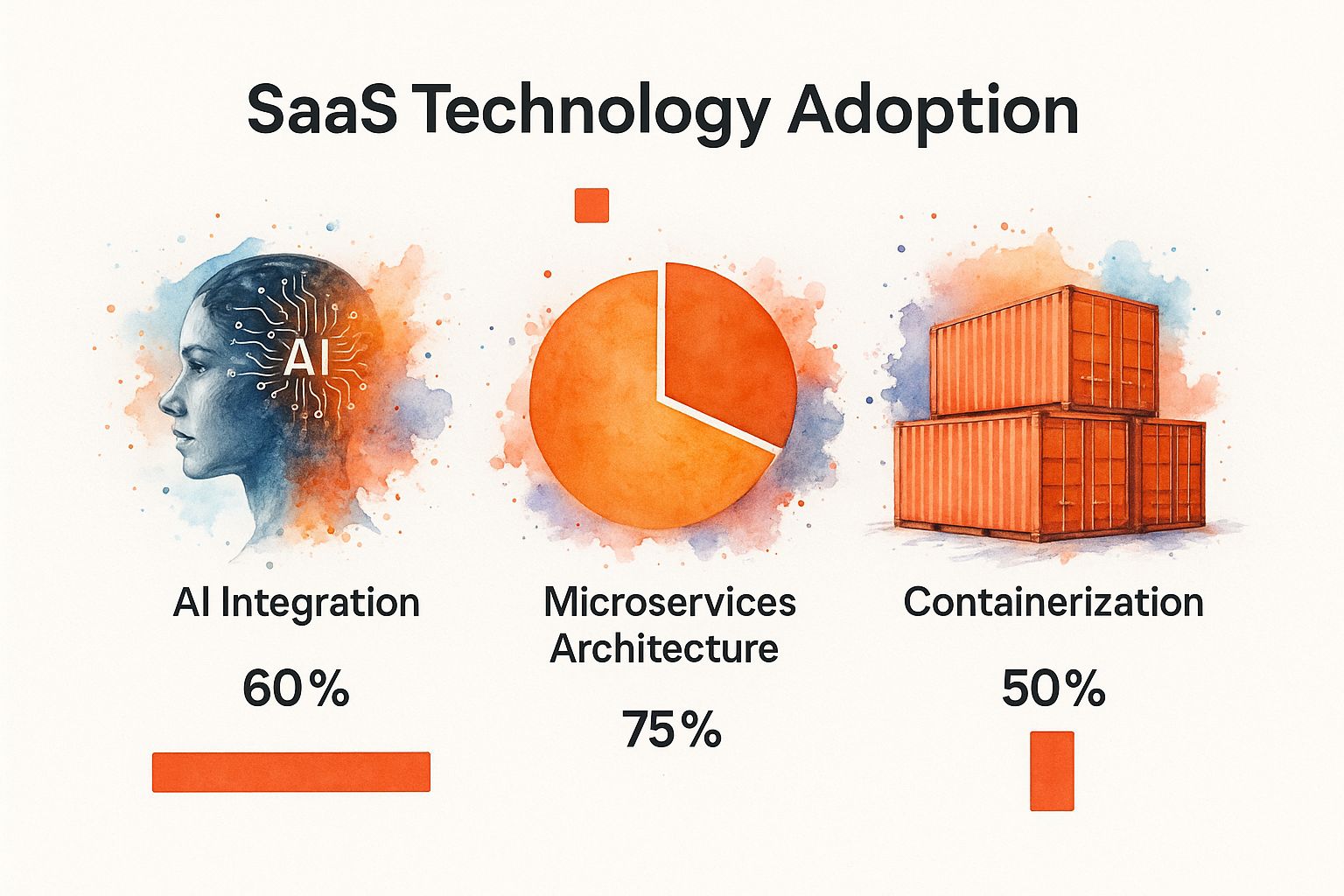Essential Trends in SaaS You Need to Know
The most important trends bubbling up in SaaS right now all circle back to a few core ideas: AI-driven automation, laser-focused niche solutions, and a renewed obsession with operational efficiency. These aren't just minor tweaks—they represent a fundamental shift in how Software-as-a-Service is perceived. It's moving beyond a simple delivery model and becoming a core business philosophy built on agility and real-world results.
The SaaS Revolution and Why It Matters Now
Ever thought about the difference between owning a car and just calling an Uber? Buying a car is a huge upfront commitment. You’ve got the sticker price, ongoing maintenance, insurance, and the nagging feeling that it’ll be outdated in a few years. That’s exactly what buying traditional software used to feel like—a big, clunky, fixed investment.
SaaS, on the other hand, is the Uber. You pay for what you need, right when you need it, without the long-term headaches of ownership. This simple but powerful shift from ownership to access has completely democratized technology. Now, businesses of any size can tap into enterprise-grade tools without the enterprise-level price tag. That flexibility is the real engine behind the SaaS revolution.
Before we dive into the specific trends shaping the industry, let's take a quick look at the major themes we'll be covering. This table gives you a high-level snapshot of what's happening and why it's so important for anyone building or running a SaaS business today.
Key SaaS Trends at a Glance
| SaaS Trend | Primary Business Impact | What You Need to Know |
|---|---|---|
| Artificial Intelligence | Moves SaaS from passive tools to proactive partners through automation and deep insights. | AI is no longer a "nice-to-have." It's becoming the standard for creating smarter, more efficient software. |
| Vertical SaaS | Delivers hyper-focused solutions that solve specific industry problems far better than generic tools. | Specialization wins. Deeply understanding one industry is more valuable than trying to serve everyone. |
| Economic Realities | Shifts the focus from "growth at all costs" to sustainable, profitable, and efficient operations. | Profitability and smart spending are back in style. Businesses need to prove their value and efficiency. |
This table is just the starting point. Each of these trends is interconnected, creating a powerful ripple effect across the entire software landscape. Now, let’s get into the details.
A Market Defined by Explosive Growth
This move toward agility isn't just a cool concept; it's backed by some serious economic momentum. The global SaaS market is in the middle of an incredible expansion, proving just how essential it has become to modern business.
In 2023, the market was already valued at around $296.9 billion. But get this—it's projected to nearly triple, hitting an estimated $829.3 billion by 2031. That’s a compound annual growth rate of about 13.7%, fueled by companies everywhere adopting cloud-based tools to work smarter, not harder. You can learn more about the factors driving this market growth and its implications to get the full picture.
Understanding the Next Chapter in SaaS
This guide is all about exploring the key trends that are writing the next chapter of the SaaS story. Think of these not as isolated events, but as interconnected forces shaping how software gets built, sold, and used every single day. Getting a handle on them is absolutely critical if you want to stay ahead of the curve.
We’re going to break down several key areas:
- Artificial Intelligence: How AI is finally moving out of the "buzzword" category and becoming a practical, hands-on tool for automation and generating real insights.
- Vertical SaaS: The surprising power of building specialized, industry-specific solutions instead of trying to create another one-size-fits-all platform.
- Economic Realities: Why the entire industry is pivoting from a "grow-at-all-costs" mindset to one focused on building efficient, sustainable, and truly valuable businesses.
How AI Is Reshaping the SaaS Landscape

Let's be honest, "AI" has been thrown around as a buzzword for years. But now, it's finally moved past the hype and become the engine driving one of the biggest trends in saas. AI is fundamentally changing what our software can do, turning passive tools into proactive partners that actually anticipate our needs.
This isn't about tacking on a "smart" feature for marketing fluff. We're talking about building entirely new capabilities into the software we rely on every single day.
Imagine a CRM that doesn't just hold your contact list but actively sifts through communication patterns to tell you which deals are most likely to close next quarter. Or a marketing tool that goes beyond scheduling posts to write entire email campaigns, personalized for each customer's behavior. This is where AI delivers real, tangible value—by turning mountains of data into predictive insights and intelligent action.
This shift is happening everywhere, from scrappy startups to enterprise giants. The goal is the same: create more intuitive, efficient, and personalized experiences that were simply out of reach just a few years ago.
From Automation to Generative Intelligence
Not all AI in SaaS is the same. It helps to think of it in layers, each adding a different level of sophistication. Understanding these layers is key to cutting through the marketing noise and spotting what’s genuinely useful.
The first and most common layer is intelligent automation. This is where AI takes over the boring, repetitive stuff, freeing up your team for more strategic work. Think of an accounting tool that automatically categorizes your expenses or flags a weird transaction for you to review. Simple, but powerful.
Next up is predictive analytics. This is where AI algorithms chew on historical data to forecast what’s likely to happen next. It's the magic behind sales forecasting, customer churn prediction, and smarter inventory management, giving businesses a crystal ball to peek into the future.
And then there's the one everyone is talking about: generative AI.
Generative AI is a massive leap forward. It allows SaaS platforms to create new things—drafting reports, generating lines of code, designing marketing visuals, or even composing thoughtful customer support replies. It’s fundamentally changing how we interact with software.
The Rush to Integrate and Its Risks
The race to bake AI into every SaaS tool is on, and it's moving fast. Projections show that around 50% of SaaS companies are on track to integrate AI by 2025. This push is fueled by a clear demand for smarter automation and hyper-personalized user experiences.
But this speed comes with a catch. As businesses connect more and more AI-powered apps into their core systems, security is becoming a massive headache. A staggering 60% of expensed applications have poor security scores.
Worse yet, with 85% of apps being completely unmanaged by IT, companies are unknowingly opening the door to huge cyber vulnerabilities. You can discover more insights about SaaS security statistics and see just how critical it is to manage these risks. It's a serious challenge for any business looking to embrace the new wave of AI-driven SaaS.
The Strategic Power of Vertical SaaS
For years, the SaaS world was all about casting a wide net. Think of those broad, one-size-fits-all platforms designed to serve just about everyone reasonably well. But one of the most important trends in saas today is a powerful swing toward specialization—the rise of vertical SaaS.
What does that mean, exactly?
Imagine you have a complex heart condition. Would you go to your general family doctor or a specialized heart surgeon? The family doctor is fantastic for everyday issues, but for something so specific, you need a true expert.
Vertical SaaS is that heart surgeon for a particular industry. It offers tools built from the ground up to solve the unique, deep-seated challenges of one specific field.
This intense focus is a massive competitive advantage. Instead of generic features that require clunky workarounds, vertical SaaS delivers highly relevant workflows, industry-specific terminology, and specialized capabilities right out of the box.
Solving Niche Problems Better Than Anyone
The real magic of a vertical SaaS company is its deep domain expertise. These aren't just software platforms; they're comprehensive solutions that genuinely understand the pains, regulations, and opportunities of a single market, whether it's construction, healthcare, or agriculture.
This industry-specific approach unlocks several key benefits:
- Built-in Compliance: For highly regulated fields like finance or medicine, vertical SaaS often comes with features that help businesses meet complex compliance standards automatically. No guesswork needed.
- Targeted Features: The product roadmap is driven entirely by the needs of one industry. This results in features that are far more valuable and useful than anything a generalist tool could ever dream of offering.
- Higher Customer Stickiness: When a platform becomes the central operating system for a business's core functions, leaving it behind for a competitor becomes incredibly difficult and costly.
For entrepreneurs, this trend opens up a world of possibilities. You can start exploring how to find these untapped markets with an app idea generator for SaaS concepts to pinpoint specific industry needs just waiting for a solution.
Vertical SaaS wins by transforming from a simple tool into an indispensable partner. It speaks the industry's language, understands its workflows, and solves its deepest problems with unmatched precision. This focus is its ultimate strategic power.
To help visualize the difference, let’s compare the two models side-by-side.
Horizontal vs Vertical SaaS Comparison
This table breaks down the core distinctions between broad, horizontal platforms and their highly specialized vertical counterparts, highlighting why focus can be such a powerful strategy.
| Aspect | Horizontal SaaS (e.g., Microsoft 365) | Vertical SaaS (e.g., Procore for Construction) |
|---|---|---|
| Target Audience | Wide range of industries and users. | A single, specific industry or niche. |
| Functionality | General-purpose features (e.g., word processing, spreadsheets). | Highly specialized, industry-specific features. |
| Market Size | Aims for a large, broad market. | A smaller, but deeper, and often less competitive market. |
| Customer Acquisition | Broad marketing campaigns, higher acquisition costs. | Targeted marketing, lower acquisition costs due to focus. |
| Competitive Advantage | Brand recognition, network effects, economies of scale. | Deep domain expertise, purpose-built workflows, high stickiness. |
| Customer Loyalty | Moderate; customers can switch to similar generic tools. | Extremely high; becomes integral to the business's core operations. |
As you can see, while horizontal SaaS aims for breadth, vertical SaaS achieves dominance through depth. It’s a classic case of being a big fish in a smaller, more profitable pond.
We've seen this model play out successfully time and time again. Just look at Procore, which built an entire platform for the construction industry, tackling everything from project management to financial tracking. By focusing exclusively on construction, they created a solution that a generic tool could never replicate, capturing a massive market segment in the process.
This approach offers a clear blueprint for building a durable, valuable SaaS business: go deep, not broad.

This chart highlights the tech adoption rates that both horizontal and vertical platforms are integrating. While AI integration is a major focus, the data shows that foundational technologies like microservices architecture are even more widely adopted. This is key, as it enables the flexibility and scalability needed to build these powerful, specialized solutions.
Adapting to the New SaaS Economy
 The SaaS world's wild "growth at all costs" party is officially over. For years, the prevailing wisdom was simple: spend whatever it takes to get more customers. But today’s economic climate has sobered up, and the spotlight has shifted to a far less glamorous but much more critical metric: efficient, sustainable growth.
The SaaS world's wild "growth at all costs" party is officially over. For years, the prevailing wisdom was simple: spend whatever it takes to get more customers. But today’s economic climate has sobered up, and the spotlight has shifted to a far less glamorous but much more critical metric: efficient, sustainable growth.
This pivot is one of the most significant trends in saas, forcing founders to toss out the old playbook. It’s not just about growing anymore; it’s about growing smart. That means embracing financial discipline, optimizing every dollar, and obsessing over long-term customer value. The conversation has moved from chasing vanity metrics to building a healthy, resilient business from the ground up.
A huge part of this new reality is finally getting a handle on customer churn. Picture your customer base as a bucket you’re constantly trying to fill. Churn is that sneaky hole at the bottom, leaking out your hard-won revenue drop by drop.
Mastering Retention in a Mature Market
In this new economy, plugging that leaky bucket isn't just a good idea—it's everything. That’s why metrics like Net Revenue Retention (NRR) have become the gold standard for measuring a SaaS company’s true health. NRR reveals how much your revenue is growing (or shrinking) from your existing customers, factoring in both upgrades and churn.
An NRR over 100% is the magic number. It means your existing customers are spending more with you over time, creating organic growth without the high cost of chasing new logos. It's the ultimate sign of a sticky product and a rock-solid customer relationship.
In a market where new customer acquisition costs are soaring, your existing customer base is your greatest asset. Focusing on NRR is no longer just a good practice—it's a survival strategy for building a durable business.
Combating the Problem of SaaS Sprawl
This push for efficiency also shines a harsh light on another costly issue: SaaS sprawl. This is what happens when a company accumulates dozens—or even hundreds—of underused or redundant software licenses. It's a silent budget killer that quietly drains resources without adding real value.
The scale of the problem is staggering. By 2025, SaaS is expected to power around 85% of all business software. But while companies use an average of 112 applications, a shocking 73% of employees don't even use all their assigned licenses. That’s a massive amount of waste. You can discover more insights about SaaS license management on Digital Silk.
To fight back, companies are turning to SaaS management platforms. These tools give them a bird's-eye view of their entire software stack, helping them spot duplicate subscriptions, consolidate tools, and reclaim wasted spend. For entrepreneurs, these inefficiencies can even be a source of inspiration. Check out our SaaS idea generator to see how you can build solutions for modern business challenges like these.
Ultimately, adapting to the new SaaS economy means running a much tighter ship. It's about refining pricing, mastering customer success, and making every single dollar count on the path to profitability.
Putting SaaS Trends into Action
Knowing the big trends in saas is one thing. But turning those high-level insights into a real, winning strategy? That’s where the magic happens. This is the moment you translate buzzy concepts like AI and vertical SaaS into a practical playbook for growth.
For SaaS founders, this is all about making deliberate, calculated moves to build something that isn't just useful today but becomes indispensable tomorrow. It demands a clear-eyed approach to how you innovate and where you position yourself in the market.
And for business leaders, it’s about navigating a ridiculously crowded software market. It's no longer enough to just pick the tool with the longest feature list; you have to cut through the noise and assess its true value, how it plugs into your existing tech, and whether the company behind it will even be around in a few years.
A Founder's Playbook for Building the Future
If you’re building a SaaS product, your roadmap needs to be grounded in these modern realities. It’s time to move from vague ideas to concrete, actionable steps that create a genuine competitive advantage.
Here’s a simple checklist to get you started:
- Embed AI with a Purpose: Don't just tack on an "AI feature" for marketing fluff. Pinpoint the single most tedious, soul-crushing task your user performs and build an AI automation that obliterates it. That’s how you deliver immediate, tangible value.
- Find Your Niche: Stop trying to build another generic project management tool. Go deeper. Could you create the ultimate platform for independent breweries? Or what about sustainable farms? Our post on SaaS idea generator strategies is a fantastic starting point for this.
- Design for Retention: Map out the entire customer journey, from that first sign-up to the renewal email. Identify every single moment where you can offer proactive support or introduce a high-value feature that makes your product stickier and boosts your Net Revenue Retention (NRR).
A Leader's Guide to Smart SaaS Adoption
For business leaders on the buying side, the goal is simple: maximize your return on investment while minimizing risk. A structured evaluation process is your best defense against costly mistakes and the dreaded "SaaS sprawl" that plagues so many companies.
When evaluating a new SaaS tool, ask one critical question: "Does this solution solve a core business problem 10x better than our current method?" If the answer isn't a resounding "yes," it's likely not worth the investment and disruption.
Before you even think about signing a contract, run every potential tool through this quick framework:
- Assess the AI's Real-World Value: Is the AI actually automating a critical process or delivering unique insights? Or is it just a gimmick? Be honest.
- Verify Integration Capabilities: How smoothly does it connect with your core systems, like your CRM or accounting software? A tool that creates data silos is a liability, not an asset.
- Investigate Vendor Viability: Is the company behind the software stable, growing, and known for great customer support? Or are they a risky bet? A great product from a shaky company is still a huge risk.
Looking Ahead at the Future of SaaS

So, where does the road lead from here? It’s pretty clear that the future of Software-as-a-Service isn’t about chasing scattered trends. Instead, think of it as a powerful, unified tide pulling the entire industry toward a smarter, more focused, and economically sound reality. Simply having a cloud-based product isn't enough anymore. The real game is constant evolution.
The path forward is built on the three core pillars we’ve unpacked. First, you have the deep integration of AI, which is turning software from a passive tool into a proactive partner. Next up is the pivot to vertical SaaS, a move that proves solving one industry's problems with precision is far more valuable than scratching the surface for everyone. And finally, the "growth-at-all-costs" playbook is dead, replaced by a sharp focus on economic efficiency that demands sustainable models and real, tangible value for customers.
From Challenge to Opportunity
It's easy to look at these shifts and see them as hurdles to clear. But that’s the wrong way to think about it. These aren't just challenges; they are massive opportunities for anyone willing to build something different and better. Each trend unlocks new doors for innovation.
- AI Integration: This is your ticket to building products that don't just do things, but predict them. You can automate complex workflows and surface insights that were previously out of reach.
- Vertical Specialization: Here’s your chance to become completely indispensable to a specific industry. You can create a solution so perfectly tailored that generic, one-size-fits-all tools simply can't compete.
- Economic Efficiency: Mastering this builds a resilient, profitable business that doesn't just survive economic storms—it thrives in them. You earn fierce customer loyalty by delivering results they can actually measure.
The future of SaaS belongs to those who adapt. The winning companies won't just see these trends as a checklist to tick off. They'll embrace them as a new operating philosophy—one built on intelligence, focus, and sustainable value.
The landscape is set, and the rules have definitely changed. Now’s the time to take a hard look at your own strategy. Are you just floating along in the market, or are you actively using these forces to build a more durable, competitive, and forward-thinking business? The choice you make today will define where you end up tomorrow.
A Few Final Questions About SaaS Trends
As you navigate the ever-shifting world of SaaS, a few questions always seem to pop up. Here are some straightforward answers to help you connect these trends to your own strategy and make smarter decisions.
What Is the Most Important SaaS Trend for a Small Business?
For most small businesses, accessible AI is the single biggest game-changer. It's not even close.
Think about the AI features now baked into the tools you already use—your CRM, your marketing platform, your customer support software. These aren't just fancy add-ons; they automate countless hours of grunt work. They pull out customer insights you'd otherwise miss and genuinely level the playing field against bigger companies, all without needing a data scientist on payroll.
At the end of the day, it’s about giving smaller teams the power to do more with less and make data-backed decisions faster than ever.
How Do I Choose Between a Horizontal and Vertical SaaS Tool?
Deciding between horizontal and vertical SaaS boils down to one simple question: how unique are your business needs? It's the classic breadth vs. depth dilemma.
If your daily operations are pretty standard and apply across most industries—things like email, basic accounting, or project management—a broad horizontal SaaS tool is usually the most efficient and budget-friendly choice.
But if your industry has its own language, specialized workflows, or strict compliance rules (think healthcare, finance, or construction), a vertical SaaS tool is almost always the right long-term move.
A vertical SaaS platform is built from the ground up to speak your industry's language. It solves your most specific headaches without forcing you into clunky workarounds that just slow everyone down.
Is the SaaS Market Too Saturated for New Companies?
Not at all, but the rules of the game have changed. Trying to go head-to-head with massive horizontal players like Microsoft or Salesforce is a recipe for disaster. That ship has sailed.
The real opportunity today is in vertical SaaS. The most successful new founders are finding a specific niche industry with misunderstood problems and then building the absolute best solution just for them.
Success in today's market isn't about going broad anymore. It’s about going incredibly deep and solving a high-value problem for a targeted audience better than anyone else can.
Ready to find your own high-value SaaS idea? The SaaSThink platform uses AI to analyze market trends and uncover profitable niches, helping you generate and validate your next big idea in minutes. Start building the future at https://www.saasthink.app.


